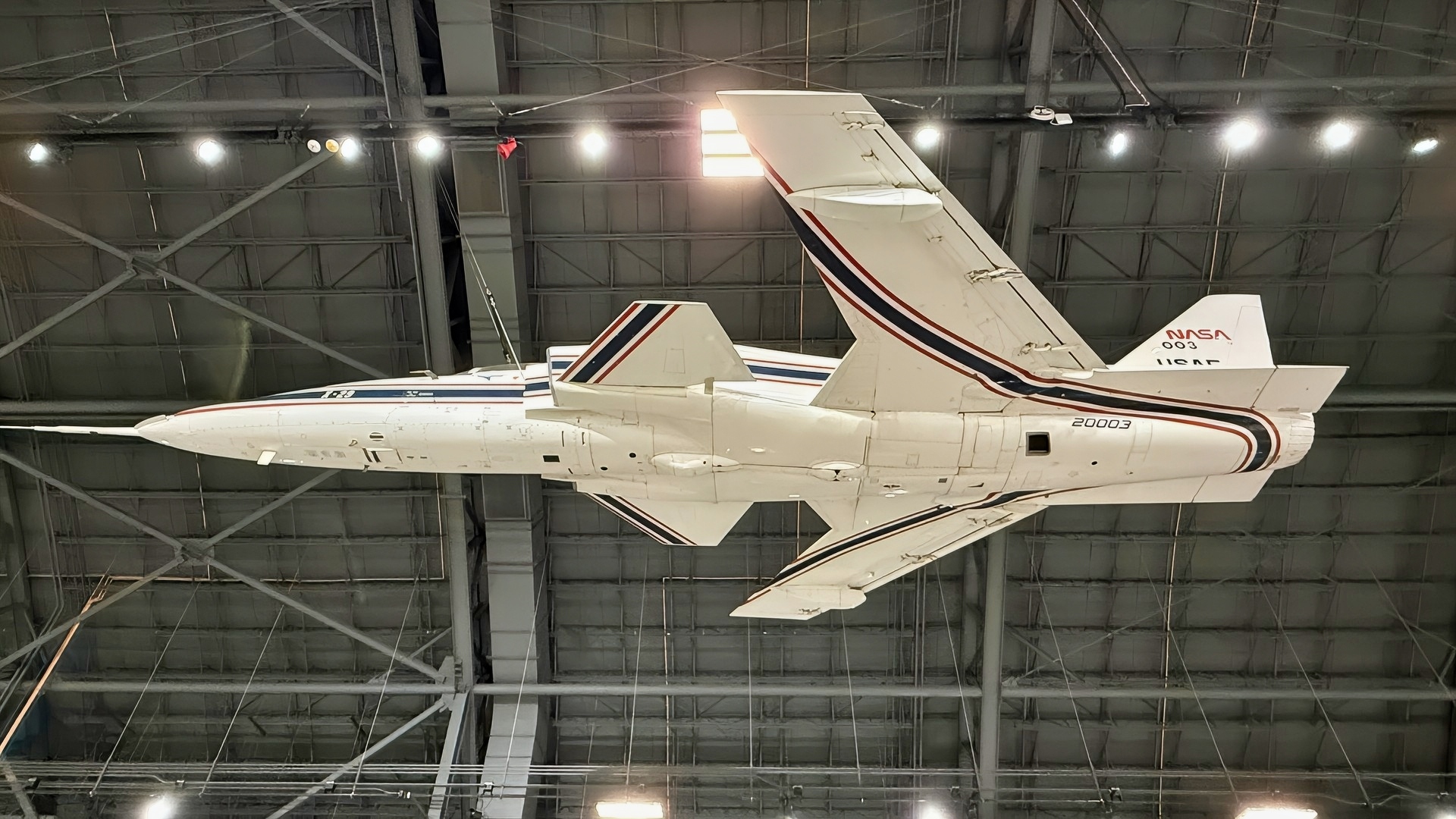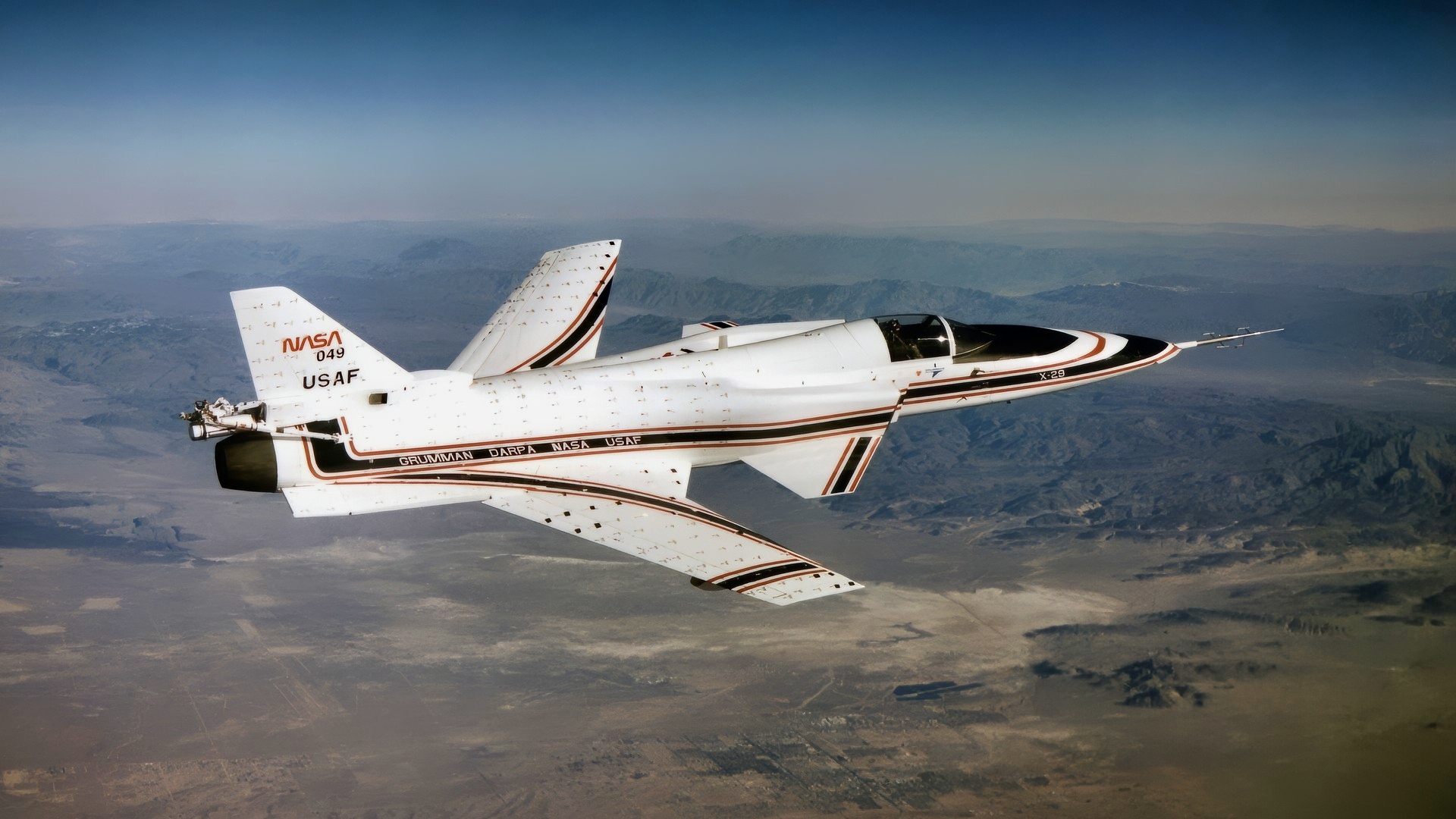Key Points and Summary – NASA and Grumman’s X-29 was a 1980s–90s technology demonstrator that flipped convention with forward-swept wings and canards to probe extreme maneuvering and high-angle-of-attack flight.
-Two jets flew 422 research sorties, revealing benefits like delayed tip stall and agile handling, enabled only by triple-redundant digital fly-by-wire making dozens of control corrections per second.

X-29. Image from the U.S. Air Force Museum. Image Credit: National Security Journal/Harry J. Kazianis.
-But structural reinforcement drove weight and drag, the design lacked stealth, and speed gains never materialized.
-Despite no operational future, X-29 work advanced fly-by-wire control laws and high-AoA understanding that fed later fighters.
-A quirky airframe, valuable lessons—just not the revolution some hoped for.
The X-29 Was One Odd Duck of an Airplane
Almost all airplanes you are familiar with have rearward-swept wings. This is better for lift and aerodynamics. But what if I told you NASA and Grumman were once working on an experimental airplane with forward-swept wings? The X-29 was an airplane that looked funky and out of place, but the egg heads at NASA wanted to figure out if this design could usher in a new era of flight.
The technology demonstrator was flown by NASA’s Ames-Dryden Flight Research Facility (now Armstrong Flight Research Center) in Edwards, California. This happened in 1990 at the end of the Cold War.
X-29: Quite A Gamble – Did It Pay Out?
NASA and Grumman wanted to see if the X-29 would have future military value and if the different design would be faster and more maneuverable.
Two X-29s demonstrated that both the aerospace contractor and the space agency had a vested interest in the project and were serious about studying high-angle-of-attack flight with forward-swept wings.
The program began in 1984 and concluded in 1992.
The design was exciting to NASA’s designers and researchers, who had nothing to lose by creating something completely different.
That’s what experimental aircraft are for – to see how new flight characteristics from unconventional design could give the U.S. military an edge. Perhaps this new shape would even help win aerial battles or conduct a ground strike by flying faster and evading radar more effectively.
More About the Design
NASA had this to say about the X-29. “The aircraft’s forward-swept wings were mounted well back on the fuselage, while its canards [horizontal stabilizers to control pitch] were in front of the wings instead of on the tail. The complex geometries of the wings and canards combined to provide exceptional maneuverability, supersonic performance and a light structure. Air moving over the forward-swept wings tended to flow inward toward the root of the wing instead of outward toward the wing tip as occurs on an aft-swept wing. This reverse airflow kept the wing tips and their ailerons from stalling at high angles of attack [direction of the fuselage relative to the air flow],” according to the agency.
Pilots were able to push the airframe to its maximum capacity with a 45-degree angle of attack.
This was a compelling feature for performance.
No fighter jet on earth had that type of angle of attack.
NASA flew the X-29 422 times, collecting a massive amount of research and development data.
The brainiacs at DARPA were also involved, assisting in the collection of flight information. This partnership aimed to help the Air Force determine if forward-swept wings were worth pursuing in new airplanes.
Problems with the Computer Power On Board
There was a big problem, as CNN pointed out.
The X-29 required a single digital flight computer on board. Otherwise, there would have been no way to make corrections during a sortie.
Forty corrections were needed each second as Christian Gelzer, chief historian at the NASA Armstrong Flight Research Center, told CNN.
However, there were three computers, and these could have failed simultaneously, rendering the airplane unflyable and putting the pilot’s life at risk. Who was responsible for this lack of foresight, since so many smart people were involved in the project? It was an “oops” moment that was going to doom the project.
The Wings Were Problematic Because of Added Weight
The wings also needed to be reinforced due to the design, Gelzer pointed out, or they would have broken up in flight.
These stronger but heavier wings created more weight and drag.
The X-29 thus could not create the kind of speed that would have made it valuable for future fighter jets.
However, the X-29 was not a total waste. It pioneered digital fly-by-wire controls. This was a new departure for the era that would be incorporated into future American fighter jets.
The X-29 was not stealthy, which further exacerbated its problems. The forward-swept wings would not be able to be coated with radar-absorbent materials.
Aircraft engineers and technicians sought radar-evasive airplanes that featured either flying wings or conventional rearward-swept wings.
X-29: This May Not Have Been a Good Idea
I’m not convinced that the X-29 was that valuable. It seems that a significant amount of time and money was invested in a project that had so few advantages. The wings were problematic, as were the flight computers.
Grumman, NASA, and DARPA would have been better served by focusing on stealth flight rather than designing unorthodox airplanes.
The X-29 will go down in history as a curious airplane, but one without a clear use case.
Sometimes, technology demonstrators do not accomplish their first mission, which is to take an unproven design and pave the way for future flight. As Gelzer concluded, thrust vectoring innovations would have been a better technology to work on.
It could have saved the government a substantial amount of money. Fortunately, this airplane was only experimental.
Don’t look for the X-29 to become part of the U.S. fighter fleet in the future.
About the Author: Brent M. Eastwood
Brent M. Eastwood, PhD is the author of Don’t Turn Your Back On the World: a Conservative Foreign Policy and Humans, Machines, and Data: Future Trends in Warfare plus two other books. Brent was the founder and CEO of a tech firm that predicted world events using artificial intelligence. He served as a legislative fellow for US Senator Tim Scott and advised the senator on defense and foreign policy issues. He has taught at American University, George Washington University, and George Mason University. Brent is a former US Army Infantry officer. He can be followed on X @BMEastwood.
More Military
China Claims New J-35 Stealth Fighter Has Radar Cross-Section ‘Smaller Than a Human Palm’
The SR-71 Blackbird Mach 3 Bomber?
5 Reasons A U.S.-China War Could Start










